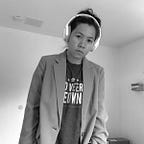Four Short Lessons From Learning Python
Python is a GREAT tool for creative work.
I went into this Python journey with little-to-no expectations other than to simply be more data literate. My main objective was to improve my quantitative thinking skills, as opposed to qualitative. Less words, and really more… numbers and charts and graphs and statistics.
Little did I know that in between working on certain concepts like Loops, Object Oriented Programming (OOP), and even Else/If Statements, ideas would just naturally come out. Creative ideas, product ideas.. only the noticeable difference was that the logic part was stronger. This time, I could actually imagine how it’ll work, not just the why and the what.
As a maker, the goal now is not just to be less dependent on code in making ideas happen but also other way around: Work towards the state where the idea (‘design’) will drive the code which will ultimately drive the product. Design will shape the technology. For designers, this lofty ambition has to be earned, and I believe learning how to speak to machines is the most obvious first step. Figma is not the only tool designers should leverage.
Finding good data is an exercise in resourcefulness.
I learned this lesson early on mainly thanks to our amazing instructor, Craig Sakuma. It is one thing to have a great idea (‘Create a dashboard to compare current electric vehicles based on their specs, prices and performance’); it is another to actually have the data to support that vision. I only had the latter.
It is incredibly difficult to attain a good quality of dataset. With tools like Kaggle, Data.world and all the other resources mentioned here, one can easily find alternatives. At least for building proof of concepts and MVPs, these platforms work. The reality is it may not be enough, and this where creativity comes into play.
It’s an imperfect system but I’ve learned that if you use your strengths to your advantage, the lack of a good quality of data shouldn’t be a blocker to making that vision a reality.
With Python, you get back what you put in.
Just like every skill that is worth pursuing, time and energy investment matter. Programming is not an easy task, I should know. Been struggling with it for years. Python, specifically, made me think about the concept of compounding interest. “Tiny improvements add up to massive differences”, this article says.
Yes, there were bad days. There was definitely a narrow period where in I was ready to just quit and cut my losses. What got me through those days (and weeks) was just showing up and trying my best to ship something. Anything. I have never felt more dumb. In retrospect, that was great thing.
Whether it’s refactoring my code or applying a logic I’ve learned in class, or hell, just copying other people’s code just to continuously develop a muscle memory, small wins matter. In this case, small wins actually got me through those tough and frustrating times over, and over again. Do not underestimate small wins. If you try hard enough, they might just turn into the sum of an even bigger win.
One does not need to be an Engineer, officially, to effectively think like one.
In this day and age, few things are as useful as Engineering skills. Trillion/Billion Dollar companies are built (and will be built) by code. I don’t need to tell you that. What I do know for sure is that, as intimidating as it sounds, it wouldn’t cost anyone to start thinking like an Engineer. Even if you, like me, have no plans of being one professionally.
It’s a superpower, not unlike Design and it starts by asking questions. Ask enough questions, and maybe just maybe, you’ll end up with the right ones. And again, just like Design, this takes a lot of practice. World class intuition development and technical skillset mastery is a lifelong pursuit. How does it work? Why does it work the way it works? What is the system behind it?
Because of learning python, I’m training myself to ask those questions more and more everyday. To find answers, yes. But more importantly, to be a little more more literate with how the world works, one system/product at a time.
The author is a User Experience Designer and a Qualitative Researcher who recently concluded an Intro to Python Bootcamp. Many thanks to General Assembly and Craig Sakuma. She would highly recommend the course for anyone who wants to learn Python and a little bit of Data Science.
More about the author
Nikki is a Sr. UX Designer working for a data company in New Jersey. In the last 2 years, she has helped design & build a holographic platform, contracted for a research team inside Fidelity Investments, worked in the Design Operations side of an e-commerce company, mentored brilliant design students/career-changers, advocated for UX best practices at RookieUp, have co-taught UX courses at General Assembly and have also contributed directly to the growth of the Mentorship program on UXPA-New York. Designing for a better world is her life. She also runs her own newsletter, working title, about her thoughts on the future and more.
